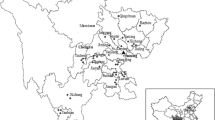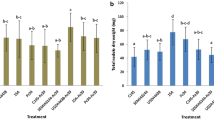Abstract
The success of rhizobial inoculation on plant roots is often limited by several factors, including environmental conditions, the number of infective cells applied, the presence of competing indigenous (native) rhizobia, and the inoculation method. Many approaches have been taken to solve the problem of inoculant competition by naturalized populations of compatible rhizobia present in soil, but so far without a satisfactory solution. We used antibiotic resistance and molecular profiles as tools to find a reliable and accurate method for competitiveness assay between introduced Bradyrhizobium sp. strains and indigenous rhizobia strains that nodulate peanut in Argentina. The positional advantage of rhizobia soil population for nodulation was assessed using a laboratory model in which a rhizobial population is established in sterile vermiculite. We observed an increase in nodule number per plant and nodule occupancy for strains established in vermiculite. In field experiments, only 9% of total nodules were formed by bacteria inoculated by direct coating of seed, whereas 78% of nodules were formed by bacteria inoculated in the furrow at seeding. In each case, the other nodules were formed by indigenous strains or by both strains (inoculated and indigenous). These findings indicate a positional advantage of native rhizobia or in-furrow inoculated rhizobia for nodulation in peanut.






Similar content being viewed by others
References
Abaidoo RC, Keyser HH, Singleton PW, Borthakur D (2002) Comparison of molecular and antibiotic resistance profile methods for the population analysis of Bradyrhizobium spp. (TGx) isolates that nodulate the new TGx soybean cultivars in Africa. J Appl Microbiol 92:109–117
Alwi N, Wynne JC, Rawlings JO, Schneeweis TJ, Elkan GE (1989) Symbiotic relationship between Bradyrhizobium strains and peanut. Crop Sci 29:50–54
Bogino P, Banchio E, Rinaudi L, Cerioni G, Bonfiglio C, Giordano W (2006) Peanut (Arachis hypogaea) response to inoculation with Bradyrhizobium sp. in soils of Argentina. Ann Appl Biol 148:207–212
Boogerd FC, van Rossum D (1997) Nodulation of groundnut by Bradyrhizobium: a simple infection process by crack entry. FEMS Microbiol Rev 21:5–27
Boote KJ (1982) Growth stages of peanut (Arachis hypogaea L.). Peanut Sci 9:35–40
Brockwell J, Gault RR, Herridge DF, Morthorpe LJ, Roughley RJ (1988) Studies on alternative means of legume inoculation: microbiological and agronomic appraisals of commercial procedures for inoculating soybeans with Bradyrhizobium japonicum. Aust J Agric Res 39:965–972
Castro S, Permigiani M, Vinocur M, Fabra A (1999) Nodulation in peanut (Arachis hypogaea L.) roots in the presence of native and inoculated rhizobia strains. Appl Soil Ecol 13:39–44
Catroux G, Hartmann A, Revellin C (2001) Trends in rhizobial inoculant production and use. Plant Soil 230:21–30
Deaker R, Roughley RJ, Kennedy IR (2004) Legume seed inoculation technology – a review. Soil Biol Biochem 36:1275–1288
Denarie J, Debelle F, Rosenberg C (1992) Signaling and host range variation in nodulation. Annu Rev Microbiol 46:497–531
De Bruijn FJ (1992) Use of repetitive (repetitive extragenic palindromic and enterobacterial repetitive intergeneric consensus) sequences and the polymerase chain reaction to fingerprint the genomes of Rhizobium meliloti isolates and other soil bacteria. Appl Environ Microbiol 58:2180–2187
Lanier JE, Jordan DL, Spears JF, Wells R, Dewayne Johnson P (2005) Peanut response to inoculation and nitrogen fertilizer. Agronomy J 97:79–84
Löbler M, Hirsch AM (1993) A gene that encodes a proline-rich nodulin with limited homology to PsENOD12 is expressed in the invasion zone of Rhizobium meliloti-induced alfalfa nodules. Plant Physiol 103:21–30
López-García S, Vásquez TEE, Favelukes G, Lodeiro AR (2002) Rhizobial position as a main determinant in the problem of competition for nodulation in soybean. Environ Microbiol 4:216–224
Mathan N, Parani M, Parida A, Nair S (1996) Random amplified polymorphic DNA analysis of root-nodulating bacterial strains from Arachis hypogaea with physiological characteristics of both fast and slow growers. Lett Appl Microbiol 23:89–92
McDermott TR, Graham PH (1989) Bradyrhizobium japonicum inoculant mobility, nodule occupancy, and acetylene reduction in the soybean root system. Appl Environ Microbiol 55:2493–2498
Peoples MB, Herridge DF, Ladha JK (1995) Biological nitrogen fixation: an efficient source of nitrogen for sustainable agricultural production. Plant Soil 174:3–28
Schultze M, Kondorosi A (1998) Regulation of symbiotic root nodule development. Annu Rev Genet 32:33–57
Somasegaran P, Hoben HJ (1994) Handbook for Rhizobia. Methods in Legume-Rhizobium Technology. Springer-Verlag, New York
Taurian T, Ibañez F, Fabra A, Aguilar OM (2006) Genetic diversity of rhizobia nodulating Arachis hypogaea L. in central Argentinean soils. Plant Soil 282:41–52
Thies JE, Singleton PW, Bohlool BB (1991) Influence of the size of indigenous rhizobial populations on establishment and symbiotic performance of introduced Rhizobia on field-grown legumes. Appl Environ Microbiol 57:19–28
Urtz BE, Elkan GH (1996) Genetic diversity among Bradyrhizobium isolates that efectively nodulate peanut (Arachis hypogaea). Can J Microbiol 188:65–75
van Rossum D, Schuurmans FP, Gillis M, Muyotcha A, Van Verseveld HW, Stouthamer AH, Boogerd FC (1995) Genetic and phenetic analyses of Bradyrhizobium strains nodulating peanut (Arachis hypogaea L.) roots. Appl Environ Microbiol 61:1599–1609
Versalovic J, Koeuth T, Lupski JR (1991) Distribution of repetitive DNA sequences in eubacteria and application to fingerprinting of bacterial genomes. Nucleic Acids Res 24:6823–6831
Vincent JM (1970) A manual for the practical study of root-nodule bacteria, IBP Handbook No. 15. Blackwell Scientific Publications, Oxford, UK
Wadisirisuk P, Danso SKA, Hardarson G, Bowen GD (1989) Influence of Bradyrhizobium japonicum location and movement on nodulation and nitrogen fixation in soybeans. Appl Environ Microbiol 55:1711–1716
Zhang X, Nick G, Kaijalainen S, Terefework Z, Paulin L, Tighe SW, Graham PH, Lindström K (1999) Phylogeny and diversity of Bradyrhizobium isolated from root nodules of peanut (Arachis hypogaea) in Sichuan, China. Syst Appl Microbiol 22:378–386
Acknowledgments
This work was supported by grants from the Secretaría de Ciencia y Técnica de la Universidad Nacional de Río Cuarto, Consejo Nacional de Investigaciones Científicas y Técnicas (CONICET), Agencia Nacional de Promoción Científica y Tecnológica (ANPCyT), and Síntesis Química SAIC. WG is a Career Member of CONICET. PB has a doctoral fellowship from CONICET. The authors thank Mr. G. Cerioni for providing field facilities in La Aguada, and Dr. S. Anderson for editing the manuscript.
Author information
Authors and Affiliations
Corresponding author
Rights and permissions
About this article
Cite this article
Bogino, P., Banchio, E., Bonfiglio, C. et al. Competitiveness of a Bradyrhizobium sp. Strain in Soils Containing Indigenous Rhizobia. Curr Microbiol 56, 66–72 (2008). https://doi.org/10.1007/s00284-007-9041-4
Received:
Accepted:
Published:
Issue Date:
DOI: https://doi.org/10.1007/s00284-007-9041-4




